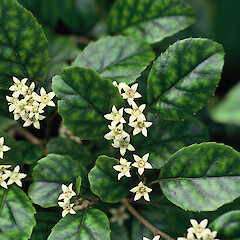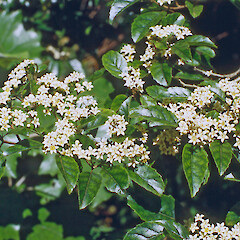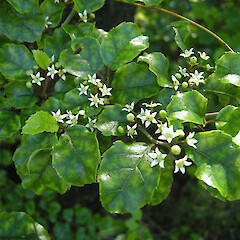Carpodetus serratus
Common name
marbleleaf, putaputawētā, piripiriwhata
Family
Rousseaceae
Flora category
Vascular – Native
Endemic taxon
Yes
Endemic genus
No
Endemic family
No
Structural class
Trees & Shrubs - Dicotyledons
NVS code
The National Vegetation Survey (NVS) Databank is a physical archive and electronic databank containing records of over 94,000 vegetation survey plots - including data from over 19,000 permanent plots. NVS maintains a standard set of species code abbreviations that correspond to standard scientific plant names from the Ngä Tipu o Aotearoa - New Zealand Plants database.
CARSER
Chromosome number
2n = 30
Current conservation status
The conservation status of all known New Zealand vascular plant taxa at the rank of species and below were reassessed in 2017 using the New Zealand Threat Classification System (NZTCS) – more information about this can be found on the NZTCS website. This report includes a statistical summary and brief notes on changes since 2012 and replaces all previous NZTCS lists for vascular plants.
Please note, threat classifications are often suggested by authors when publications fall between NZTCS assessment periods – an interim threat classification status has not been assessed by the NZTCS panel.
- Conservation status of New Zealand indigenous vascular plants, 2017 . 2018. Peter J. de Lange, Jeremy R. Rolfe, John W. Barkla, Shannel P. Courtney, Paul D. Champion, Leon R. Perrie, Sarah M. Beadel, Kerry A. Ford, Ilse Breitwieser, Ines Schönberger, Rowan Hindmarsh-Walls, Peter B. Heenan and Kate Ladley. Department of Conservation. Source: NZTCS and licensed by DOC for reuse under the Creative Commons Attribution 4.0 International licence.
2017 | Not Threatened
Previous conservation statuses
2012 | Not Threatened
2009 | Not Threatened
2004 | Not Threatened
Brief description
Small tree with smallish round or oval distinctively mottled (hence common name) toothed leaves; branchlets zig-zag (particularly when young).
Distribution
Endemic. Widespread. North, South and Stewart Islands.
Habitat
Coastal to montane (10-1000 m a.s.l.). Moist broadleaf forest, locally common in beech forest. A frequent component of secondary forest. Streamsides and forest margins.
Wetland plant indicator status rating
Information derived from the revised national wetland plant list prepared to assist councils in delineating and monitoring wetlands (Clarkson et al., 2021 Manaaki Whenua – Landcare Research Contract Report LC3975 for Hawke’s Bay Regional Council). The national plant list categorises plants by the extent to which they are found in wetlands and not ‘drylands’. The indicator status ratings are OBL (obligate wetland), FACW (facultative wetland), FAC (facultative), FACU (facultative upland), and UPL (obligate upland). If you have suggestions for the Wetland Indicator Status Rating, please contact: [Enable JavaScript to view protected content]
FACU: Facultative Upland
Occasionally is a hydrophyte but usually occurs in uplands (non-wetlands).
Detailed description
Monoecious small tree up to 10 m tall. Trunk slender, bark rough, corky, mottled grey-white, often knobbled due to insect boring. Juvenile plants with distinctive zig-zag branching which is retained to a lesser degree in branchlets of adult. Leaves broad-elliptic to broad-ovate or suborbicular; dark green, marbled; membranous becoming thinly coriaceous; margin serrately toothed; tip acute to obtuse. Juvenile leaves 10-30 mm x 10-20 mm. Adult leaves 40-60 mm x 20-30mm. Petioles c. 10 mm; petioles, peduncles and pedicels pubescent; lenticels prominent. Flowers in panicles at branchlet tips; panicles to 50 x 50 mm; flowers 5-6 mm diam.; calyx lobes c. 1 mm long, triangular-attenuate; petals white, ovate, acute, 3-4 mm long. Stamens 5-6, alternating with petals; filaments short. Stigma capitate, tip dark; ovules many. Fruit an indehiscent subfleshy-fleshy capsule, 4-6 mm diam., black when mature; cupped in remains of calyx. Seeds many per capsule, in 3-5 locules, small, 1-2 mm long; testa reticulate.
Similar taxa
Not likely to be confused with any other NZ shrub or small tree. Perhaps most similar to juvenile kaikōmako (Pennatia corymbosa) which does not have mottled leaves and the leaves are only toothed in the top half (reminiscent of a ducks foot).
Flowering
November-March
Flower colours
White
Fruiting
January-February (though dried fruit present at any time)
Life cycle
Fleshy berries are dispersed by frugivory (Thorsen et al., 2009).
Etymology
carpodetus: Fruit bound together (girdled)
serratus: Saw-toothed
Notes
This species is damaged by the burrowing larvae of the native puriri moth (Aenetus virescens). Caterpillars create burrows in the trunk and feed on cambium at the burrow entrance, creating characteristic diamond-shaped feeding scars. The caterpillar hides the web entrance with a silken web. Heavy feeding can weaken trees, in particular those with thin trunks. For more information about the life-cycle of the puriri moth and a list of other host species follow this link (Martin, 2010).
Attribution
Description adapted from Allan (1961), puriri moth information modified from Martin (2010).
References and further reading
Allan, H.H. 1961. Flora of NZ I. Government Printer, Wellington.
Martin, N.A. 2010. Puriri moth - Aenetus virescens fact sheet, retrieved from the website Interesitng Insects and other Invertebrates. http://nzacfactsheets.landcareresearch.co.nz/factsheet/OrganismProfile/Puriri_moth_-_Aenetus_virescens.html
Thorsen, M.J.; Dickinson, K.J.M.; Seddon, P.J. 2009. Seed dispersal systems in the New Zealand flora. Perspectives in Plant Ecology, Evolution and Systematics 11(4): 285-309.
















